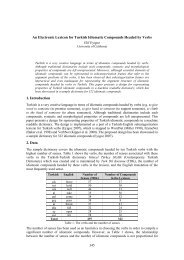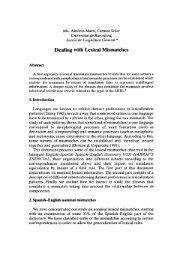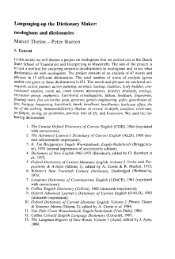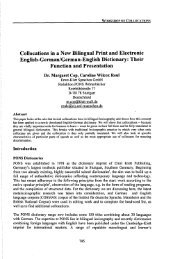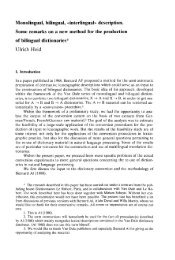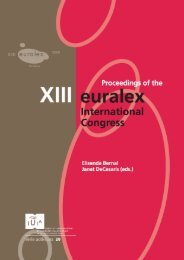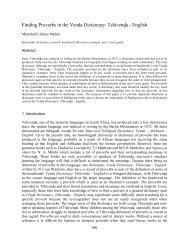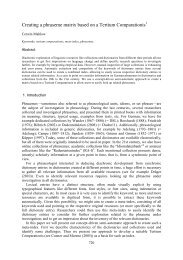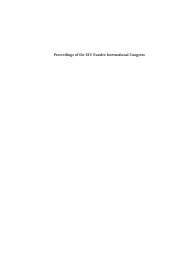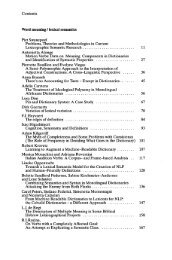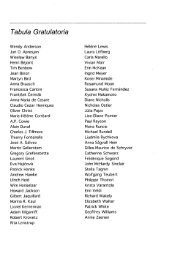Lexicon Creator: A Tool for Building Lexicons for Proofing ... - Euralex
Lexicon Creator: A Tool for Building Lexicons for Proofing ... - Euralex
Lexicon Creator: A Tool for Building Lexicons for Proofing ... - Euralex
Create successful ePaper yourself
Turn your PDF publications into a flip-book with our unique Google optimized e-Paper software.
T. Fontenelle, N. Cipollone, M. Daniels, I. Johnson<br />
analysis. Analyses with fewer segments (which are a priori better analyses) are displayed first.<br />
The analysis shows that this non-lexicalized compound is analyzed as the noun inspeksjon<br />
followed by the noun arbeid.<br />
Dynamic compounding logic can be defined directly in the template lexicon. Declarative<br />
descriptions of legal compound structures are entered via an editor: these “segment rules” are in<br />
fact regular expressions over literal characters and classes of entries in the lexicon. The classes<br />
are defined by “segmentation bits”, which are present on every runtime lexicon entry. Encoding<br />
dynamic compounding <strong>for</strong> a language thus reduces to:<br />
1. deciding what classes of lexical entries there need to be;<br />
2. writing the correct segment rules to combine these classes of lexical entries;<br />
3. populating the lexical entry classes appropriately – in other words, assigning the<br />
segmentation bits.<br />
One such rule in Norwegian could stipulate that valid compound structures have the <strong>for</strong>m<br />
*, which means that valid compounds are made up of an initial segment<br />
Seg1 followed by 0, 1 or more medial segments marked as Seg2 followed by a final segment<br />
marked as Seg3. In the example given above, this means that the inflected <strong>for</strong>m inspeksjons will<br />
need to be annotated as Seg1 (like all word <strong>for</strong>ms that can be initial segments) and arbeid will<br />
need to be annotated as Seg3 in the lexicon (like all word <strong>for</strong>ms that can be a final segment).<br />
These segmentation annotations would of course be annotated on the most general applicable<br />
level, often the template class slot level, to then cascade down to the individual inflected <strong>for</strong>ms.<br />
The runtime engine driving the spell-checker will include the same logic to determine the valid<br />
compound patterns and flag those compounds that are not permitted by this logic. In addition to<br />
the definition of segment classes, <strong>Lexicon</strong> <strong>Creator</strong> also makes it possible to configure rules<br />
according to the number of segments that can enter a valid compound, as well as to the length of<br />
segments (e.g. <strong>for</strong> a given language, the linguist might specify that each segment should be at<br />
least 3 characters long) or the minimum length of a non-lexicalized compound.<br />
Derivational morphology<br />
<strong>Lexicon</strong> <strong>Creator</strong> provides functionality to capture phenomena related to derivational<br />
morphology, which creates new words (usually, though not necessarily, of a different part of<br />
speech) by adding a bound morpheme to a base <strong>for</strong>m. For example:<br />
Adj → Adv in -ly: quick → quickly<br />
Adj → Verb in -en: bright → brighten<br />
A flexible environment enables the linguist to create derivational rules and to specify constraints<br />
allowing or blocking the application of these rules to limit overgeneration. One could <strong>for</strong><br />
instance indicate that a given rule applies only if the source lexical entry is not tagged as Vulgar.<br />
366


